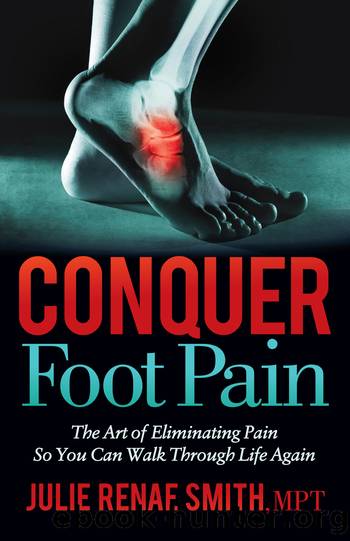Conquer Foot Pain by Julie Renae Smith

Author:Julie Renae Smith [Julie Renae Smith]
Language: eng
Format: epub
Publisher: Morgan James Publishing
Published: 2020-03-15T00:00:00+00:00
CHANGING THE PAIN SIGNAL AND INTERPRETATIONS
Changing the signal can happen several ways. Pain-gate being one way. Pain-gate occurs by interrupting the pain signal with a touch signal. If you visualize the pain pathway as a side street and the touch pathway as a highway; if you take the highway you get there faster. Therefore, if the pain is taking the side streets, and the touch is taking the highway, touch can get to the spinal cord faster and essentially âshut the doorâ so you donât interpret/hear the pain. Distraction from pain is another; if you concentrate on something else, you change what the brain is attending to. How you think about pain is another way, if you use some of the alternative classifications we were talking about earlier, like sore or productive discomfort, your interpretation of the signal is altered to either be more tolerable, a good experience, a reparative experience, or similar, instead of just having pain.
Your interpretation can also affect how treatments work. If you think the medication is going to help, itâs much more likely to. If you think the massage is going to hurt or make it worse, then likely that will be the outcome. Your brain is very powerful. Ever heard the phrase, âmind over matter?â This is mind over body. However, you want to use your right brain and body, which is experiential, to be the controller and tell the left, interpreter brain how you want it to classify and how you want it to behave the next time this same stimulus comes up. If you tell it to run the stress-trauma program you will have higher pain levels, more muscular tension, more misalignments, and more negative thoughts associated with the experience. If you tell it to run the healing program, you will have lower pain levels, faster healing, less muscle tension and misalignment, fewer compensations, and positive thoughts associated with the experience.
Which sounds more supportive and helpful? All of the psychological stuff Iâve read indicates that positive thought, positive reinforcement, positive actions all result in bigger, stronger, faster, better. That sounds better than the stress-trauma program, where stuff hurts more and heals slower.
As you move into changing how you view pain, you can change your expectations of healing. If you think something will heal quickly, then thereâs a good chance it will. If you think that your tools in your toolbox will be right for the job, chances are they will be. If you have exercises, stretches, activities, and body communication in your toolbox you have a great chance of healing quickly. As you begin to understand what is happening in your body thatâs resulting in a pain stimulus, what should actually be happening, how to listen to your body and what itâs telling you it needs to heal, and setting your mindâs classifications and interpretation you set yourself up for success.
Chris was dealing with chronic pain, mostly from past injuries that had not been addressed, which resulted in significant body pain (everywhere).
Download
This site does not store any files on its server. We only index and link to content provided by other sites. Please contact the content providers to delete copyright contents if any and email us, we'll remove relevant links or contents immediately.
Men In Love by Nancy Friday(4315)
Everything Happens for a Reason by Kate Bowler(4063)
The Immortal Life of Henrietta Lacks by Rebecca Skloot(3821)
Why We Sleep by Matthew Walker(3768)
The Sports Rules Book by Human Kinetics(3582)
Not a Diet Book by James Smith(2715)
The Emperor of All Maladies: A Biography of Cancer by Siddhartha Mukherjee(2427)
Sapiens and Homo Deus by Yuval Noah Harari(2406)
Day by Elie Wiesel(2238)
Endless Forms Most Beautiful by Sean B. Carroll(2080)
Angels in America by Tony Kushner(2046)
A Burst of Light by Audre Lorde(1979)
Hashimoto's Protocol by Izabella Wentz PharmD(1893)
Dirty Genes by Ben Lynch(1854)
Reservoir 13 by Jon McGregor(1848)
Stretching to Stay Young by Jessica Matthews(1711)
Fat for Fuel by Joseph Mercola(1693)
The Immune System Recovery Plan by Susan Blum(1687)
Boost Your Brain Power in 60 Seconds by Michelle Schoffro Cook(1676)
